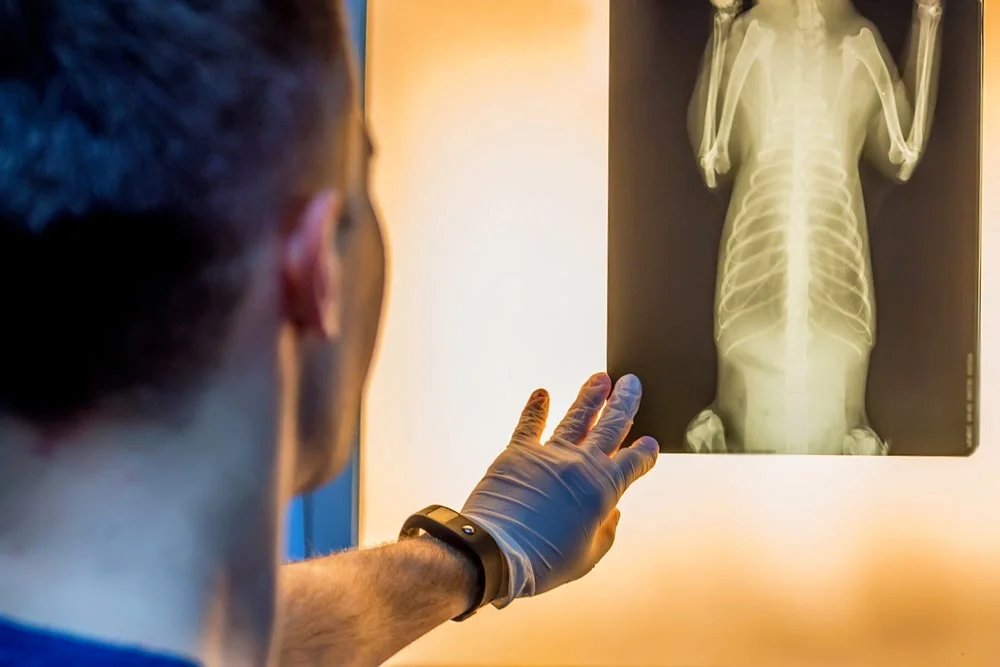PET HEALTH
If you’ve ever been in a situation where your dog is injured or sick, you know how scary it can be to bring them to the vet and have an array of tests run. One of the most common diagnostic tests is an X-ray, which can be used to identify illness or injury. They can also be used preventatively to check in on your dog’s health or monitor their recovery after a procedure.
So how much is an X-ray for a dog? On average, they can cost between $150 and $250, but the price varies depending on a few factors.1 Learn more about how X-rays are used to help your dog, the costs associated with X-rays, and how you can save.
What Is an X-Ray and Why Would My Dog Need One?
X-rays — also known as radiographs — are diagnostic imaging tests that penetrate tissue to show internal structures, like bones and teeth, as well as some soft tissues, like the kidneys and liver.2 The process is similar to human X-rays, although the voltage is different to accommodate differences in human and dog anatomy.
- Some common reasons your veterinarian may recommend your dog get an X-ray include:
- If you suspect they’ve ingested a foreign object
- If your dog may have an internal injury of some kind
- If they’re getting a routine dental cleaning
- To confirm or monitor pregnancy
If your dog is choking on something, vomiting, limping, or otherwise acting unlike themselves, it’s a good idea to bring them to the vet for an exam. X-ray testing allows your vet to make informed decisions regarding your dog’s care and can help them identify next steps. An X-ray can give a clearer picture of your dog’s internal issue and determine whether surgery or some expert maneuvering is needed.2
Below are some conditions that can be identified from an X-ray:1
- Endodontic disease
- Broken bones, bone abnormalities, and joint health
- Abnormal shape and size of liver, kidneys, and spleen
- Tumors and certain cancers
- Intestinal blockages or foreign objects in the body
- Pregnancy
Depending on the results of your dog’s X-ray test, your vet may recommend other tests — like a CT scan, ultrasound, and/or blood work — so they can determine a more thorough treatment plan.
What To Expect During Your Dog’s X-Ray
Your dog may need an X-ray for an emergency concern or a scheduled check-up, like a dental appointment. The good news is you don’t need to prepare your dog for this appointment, as it’s a relatively simple diagnostic test that can be done with everything your vet or emergency clinic has on hand.
Your dog will need to be still while the X-ray machine captures the image, so your vet might sedate them or administer anesthesia, depending on their temperament or condition. However, if your dog is able to remain comfortably still on an examination table while getting the X-ray, sedation may not be necessary. If your dog requires sedation or anesthesia, the process can take a bit longer. Ultimately, the images only take a few moments to capture, making it a simple and effective test.
Are dog X-rays safe?
X-rays for dogs are considered relatively safe, but they’re commonly reserved for specific instances only when required. Because of the electromagnetic radiation used to create an image, X-ray technicians and your dog wear protective coverings during the process as you wait outside of the room.2
What’s the difference between an X-ray and a CT scan?
In short, X-rays are less detailed than CT scans and don’t draw the same conclusions. CT scans show different levels of tissue density and more detailed images compared to X-rays. CT scans require your dog to be sedated and are commonly used to identify tumors, deep abscesses, foreign bodies, and broken bones.3 An X-ray may offer initial information, which a CT scan can then confirm.
What Impacts a Dog X-Ray Cost?
On average, dog X-rays cost around $150 – $250, but they can range from $75 – $500.1 Prices vary depending on your emergency clinic or vet, as well as a few other factors. These include the size of your dog, how many images are needed, whether sedation is required, and where the X-ray site is located. For example, you may find that getting a dog X-ray of the stomach costs more than one for their paw, and a dog X-ray of the leg costs less than X-raying their teeth.
Your vet should be able to give you a quote prior to your vet visit if you’re scheduling ahead of time, or before moving forward with the X-rays if you’re already in the clinic. But imaging may be necessary to help your vet best determine your dog’s treatment plan.
How To Save on Dog X-Ray Costs
X-ray testing is often necessary to help confirm a diagnosis for an illness, injury, or other condition inflicting your pooch. Consider investing in a dog insurance policy from MetLife Pet to help offset the cost of diagnostic testing, like X-rays. Here’s how much some of our existing customers have been reimbursed on X-ray bills:4
- Over $620: Dog parents in Pennsylvania saved big on their bill for 1-year-old Doug’s X-ray procedure.
- About $270: A 9-year-old German shepherd’s X-ray bill was almost entirely reimbursed in Ohio.
- Nearly $370: A 1-year-old Yorkshire terrier named Biscuit needed X-rays, and his owner’s were reimbursed for nearly the full cost.
Learn more about how much pet insurance costs or fetch a quote today to see what your personalized rate might be.
Need an X-ray To Help With Your Dog’s Diagnosis?
Dr. Hunter Finn has been paid by MetLife to discuss the importance of choosing pet insurance. He is an integrative veterinary expert first, and social media star second. America’s favorite veterinarian owns Pet Method in McKinney, Texas, where he cares for pets while prioritizing their emotional well-being. When he’s not at his clinic, he’s starring in viral videos on TikTok (2 million followers) and Instagram (500K followers) — where he’s been known to snuggle puppies and conquer the latest dance trends.


